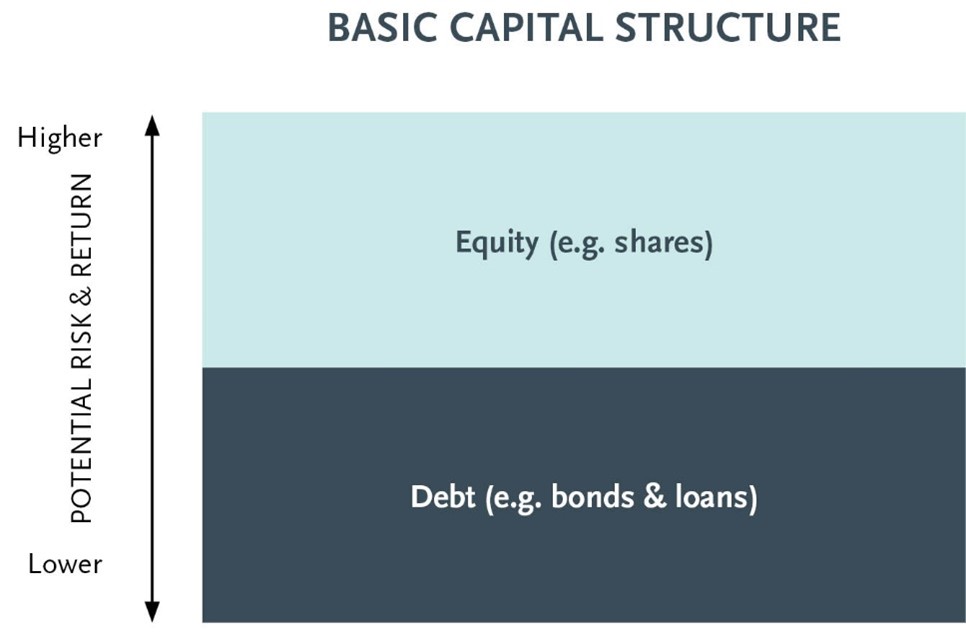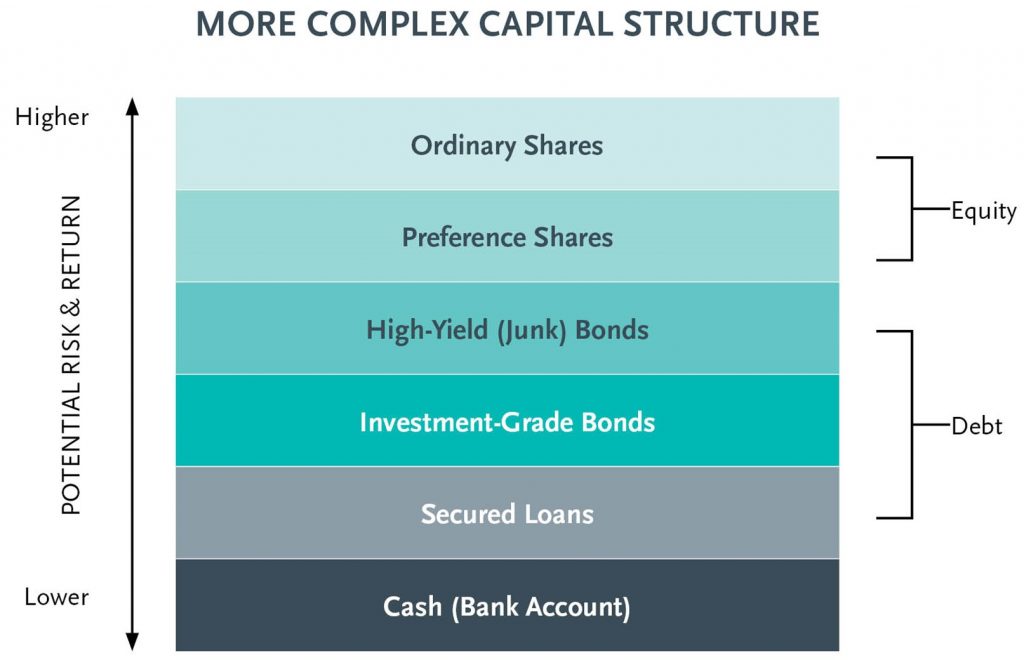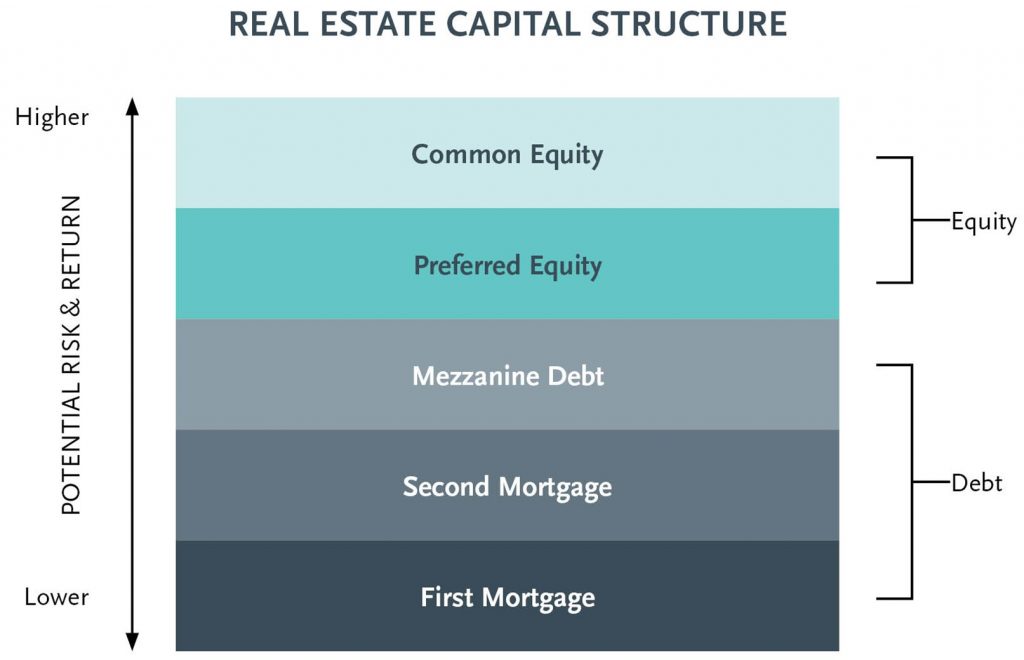How to build your investments with a capital structure
To invest well, you need to consider your financial goals, investing time frame and risk tolerance. Investment risk is the likelihood that you’ll lose some or all the money you’ve invested due to an investment falling in value or not performing as expected.
The capital structure of an investment is a useful tool that enables you to compare a wide range of investments in terms of their risk and the potential returns they offer.
The higher you are on a capital structure, the higher your risk and the greater your potential returns. Conversely, the lower you are on the capital structure, the lower your risk but the less you are likely to earn over time.

Figure 1: A basic capital structure
In the case of a very basic capital structure consisting only of debt and equity, equity sits at the top as shown in Figure 1. It is expected to produce the greatest profit in the long run.
From Figure 1, being on the bottom is not necessarily a bad thing when it comes to capital structures, because the debt values higher in capital security than equity. Investors here take precedence over equity holders.
As a shareholder, you can expect to receive dividend payments when a company performs well, but you may get no dividends at all when it experiences difficult times.
Bondholders, on the other hand, generally expect more predictable returns based on agreed rates of interest. That’s why investments in bonds and other forms of long-term debt are referred to as fixed-income investments.
As with shares, bond prices can move, but they are generally less volatile. It’s also important to remember that equity investors such as shareholders of companies face greater risk of losing their capital altogether because they are the last to be repaid should a company fail.
To build a well-balanced portfolio, you should invest across the different levels of the capital structure, accumulating a diverse mix of growth and defensive assets that suits your risk profile by spreading your investments across several asset classes such as property, bonds and shares. These can be invested in directly or through professionally managed investment funds and Exchange Traded Funds (ETFs).
In reality, capital structures are seldom as simple as that in Figure 1. For example, equity holders may be divided into ordinary shareholders and preference shareholders. The dividends of preference shares are paid out before those of ordinary shares, so they occupy a slightly safer niche further down the capital structure.

Figure 2: A more complex capital structure
And there are many different types of bonds too. High-yield bonds offer better rates of return than investment-grade bonds, but they are sometimes disparagingly referred to as ‘junk' bonds because they are deemed more risky than those bonds with investment-grade ratings, and they have a higher probability of not paying their debt back. For retail investors, fixed-income funds and ETFs may offer exposure to either type of bond or a combination of both.
Even further down the capital structure than bonds are secured loans, so-called because they are secured against assets offered as collateral. And right at the bottom of the structure is the safest asset of all, cash, which also earns the lowest returns.
Typical capital structure in real estate investment
Most homeowners understand the difference between their mortgage and the equity they have in their home. But when it comes to property investing, the capital structure can be complex. It may involve numerous parties and a variety of layers, which can change significantly over the life of a project.

Figure 3: Real estate capital structure
The most secure position on the real estate capital structure – at the bottom – is typically held by debt secured by first mortgages. This is often referred to as senior debt because it has the very highest priority when it comes to repayment.
A first mortgage protects a lender from financial loss by giving them the right to take possession of the property and sell it should a borrower stop making loan repayments. Only once the first mortgage holder has been repaid all their capital and interest can any remaining proceeds from the sale be shared by other investors.
When there is already a mortgage over a property, it is possible to register additional mortgages. In this case, second mortgages rank higher up the capital structure, followed by third mortgages, and so on.
As they are riskier for lenders, these investments attract higher rates of interest than debt secured by first mortgages. They are sometimes referred to as junior debt or mezzanine debt because like the mezzanine floor of a building they sit above the bottom layer.
NB: The term ‘mezzanine debt’ is often used loosely to refer to various types of high-risk junior debt that may not necessarily be secured by mortgages and sometimes blur the line between debt and equity.
As is always the case, equity occupies the highest and most risky spot on the real estate capital structure. The owners of a property may profit handsomely or lose their entire investment, depending on how much debt they must repay and how well or poorly the property performs financially.
In the same way that managed funds and ETFs can give retail investors access to the world of fixed income, other investment funds such as property funds or mortgage trusts enable them to invest in property-related debt.
Find out more
To find out more about property funds, such as mortgage trusts and whether they may be a suitable investment option for you, visit our website.

